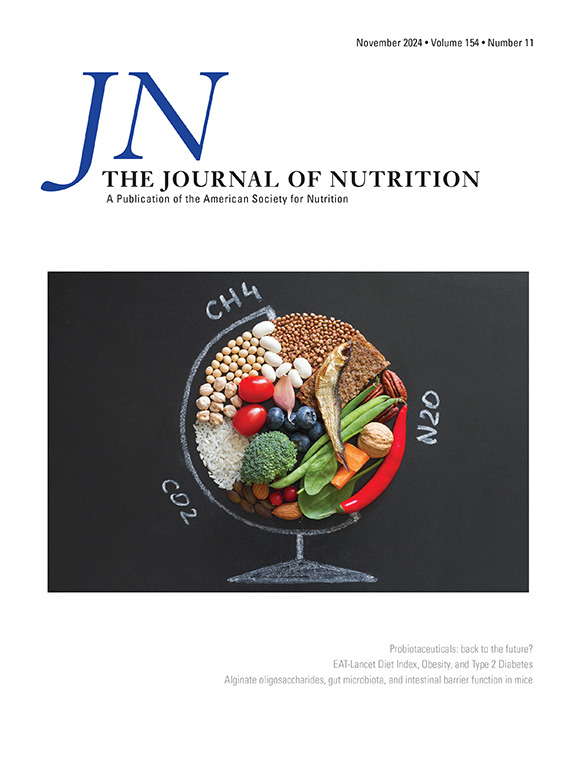孟加拉国农村母乳宏量营养素和能量浓度的母婴预测因子:一项观察性队列研究。
IF 3.7
3区 医学
Q2 NUTRITION & DIETETICS
引用次数: 0
摘要
背景:母乳中的主要营养素(蛋白质、脂肪和碳水化合物)和能量浓度因母婴因素和产后时间的不同而变化:确定产后约 2 个月至 5 个月期间乳汁中主要营养素和能量浓度的变化,并确定与孟加拉国哺乳队列中这种变化相关的因素:在孟加拉国锡尔赫特农村地区进行的前瞻性哺乳期队列观察中,我们收集了手工挤出的母乳样本,并使用中红外光谱分析法分析了母乳中的宏量营养素浓度。我们使用 Wilcoxon 秩和检验来比较各时间点之间的宏量营养素和能量浓度,并使用混合线性回归来确定预测因素(母亲体重指数[BMI]、母亲中上臂围、婴儿胎龄和婴儿小于胎龄(SGA)状况)与重复测量的乳汁宏量营养素和能量浓度之间的关系,该模型已对奇偶性、尼古丁和财富指数进行了调整:我们招募了 99 名参与者。从访问 1(∼2 个月)到访问 2(∼5 个月),牛奶蛋白质浓度中位数从 1.4 g/dL (IQR 1.1, 1.6) 降至 0.8 g/dL (IQR 0.6, 1.1),脂肪浓度中位数从 4.6 g/dL (interquartile range [IQR] 3.8, 5.5) 降至 2.8 g/dL (IQR 2.1, 3.7),能量浓度中位数从 22.7 kcal/oz (IQR 20.6, 25.1) 降至 17.5 kcal/oz (IQR 15.6, 19.9)。母亲超重与碳水化合物浓度较低有关(2 个月:平均差 [MD] -0.16 g/dL [95% 置信区间 [CI]-0.28,-0.03];5 个月:平均差 [MD] -0.14 g/dL [95% 置信区间 [CI]-0.28,-0.03]):结论:随着时间的推移,蛋白质、脂肪和能量浓度的下降是孟加拉国母乳喂养婴儿这一弱势群体的潜在担忧,因为这些营养素对婴儿的生长和神经发育有影响。本文章由计算机程序翻译,如有差异,请以英文原文为准。
Maternal and Infant Predictors of Human Milk Macronutrient and Energy Concentrations in Rural Bangladesh: An Observational Cohort Study
Background
Human milk macronutrient (protein, fat, and carbohydrate) and energy concentrations vary based on maternal and infant factors and time postpartum.
Objectives
This study aimed to determine the change in milk macronutrient and energy concentrations from approximately 2 to 5 months postpartum and identify factors associated with this variation among a lactation cohort in Bangladesh.
Methods
In this prospective observational lactation cohort in rural Sylhet, Bangladesh, we collected hand-expressed mid-feed human milk samples and analyzed macronutrient concentrations using mid-infrared spectroscopy. We used the Wilcoxon rank-sum test to compare macronutrient and energy concentrations between time points and mixed linear regression to determine associations between predictors [maternal body mass index (BMI), maternal mid-upper arm circumference, infant gestational age, and infant small for gestational age status] and repeated measures of milk macronutrient and energy concentrations in models adjusted for parity, nicotine, and wealth index.
Results
We enrolled 99 participants. From visit 1 (∼2 mo) to visit 2 (∼5 mo), median milk protein concentration decreased from 1.4 g/dL [interquartile range (IQR): 1.1–1.6 g/dL] to 0.8 g/dL (IQR: 0.6–1.1 g/dL), median fat concentration decreased from 4.6 g/dL (IQR: 3.8–5.5 g/dL) to 2.8 g/dL (IQR: 2.1–3.7 g/dL), and median energy concentration decreased from 22.7 kcal/oz (IQR: 20.6–25.1 kcal/oz) to 17.5 kcal/oz (IQR: 15.6–19.9 kcal/oz). Maternal overweight status was associated with a lower carbohydrate concentration (2 mo—mean difference: −0.16 g/dL; 95% CI: −0.28, −0.03 g/dL; 5 mo—mean difference: −0.14 g/dL; 95% CI: −0.26, −0.02; reference = normal BMI).
Conclusions
The decline of protein, fat, and energy concentrations over time is a potential concern for Bangladesh’s vulnerable population of human milk–fed infants, as these nutrients have implications for infant growth and neurodevelopment.
求助全文
通过发布文献求助,成功后即可免费获取论文全文。
去求助
来源期刊

Journal of Nutrition
医学-营养学
CiteScore
7.60
自引率
4.80%
发文量
260
审稿时长
39 days
期刊介绍:
The Journal of Nutrition (JN/J Nutr) publishes peer-reviewed original research papers covering all aspects of experimental nutrition in humans and other animal species; special articles such as reviews and biographies of prominent nutrition scientists; and issues, opinions, and commentaries on controversial issues in nutrition. Supplements are frequently published to provide extended discussion of topics of special interest.
 求助内容:
求助内容: 应助结果提醒方式:
应助结果提醒方式:


